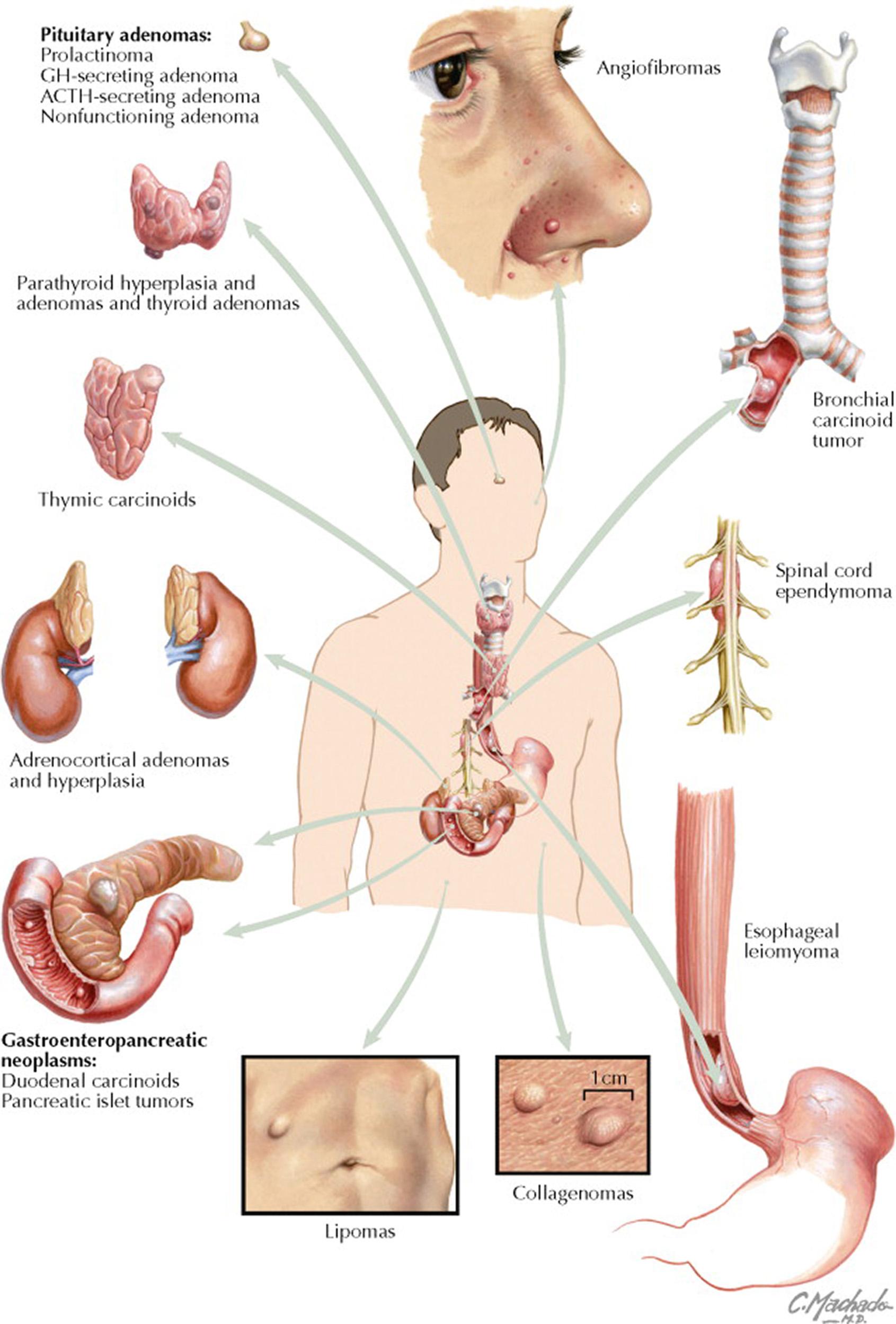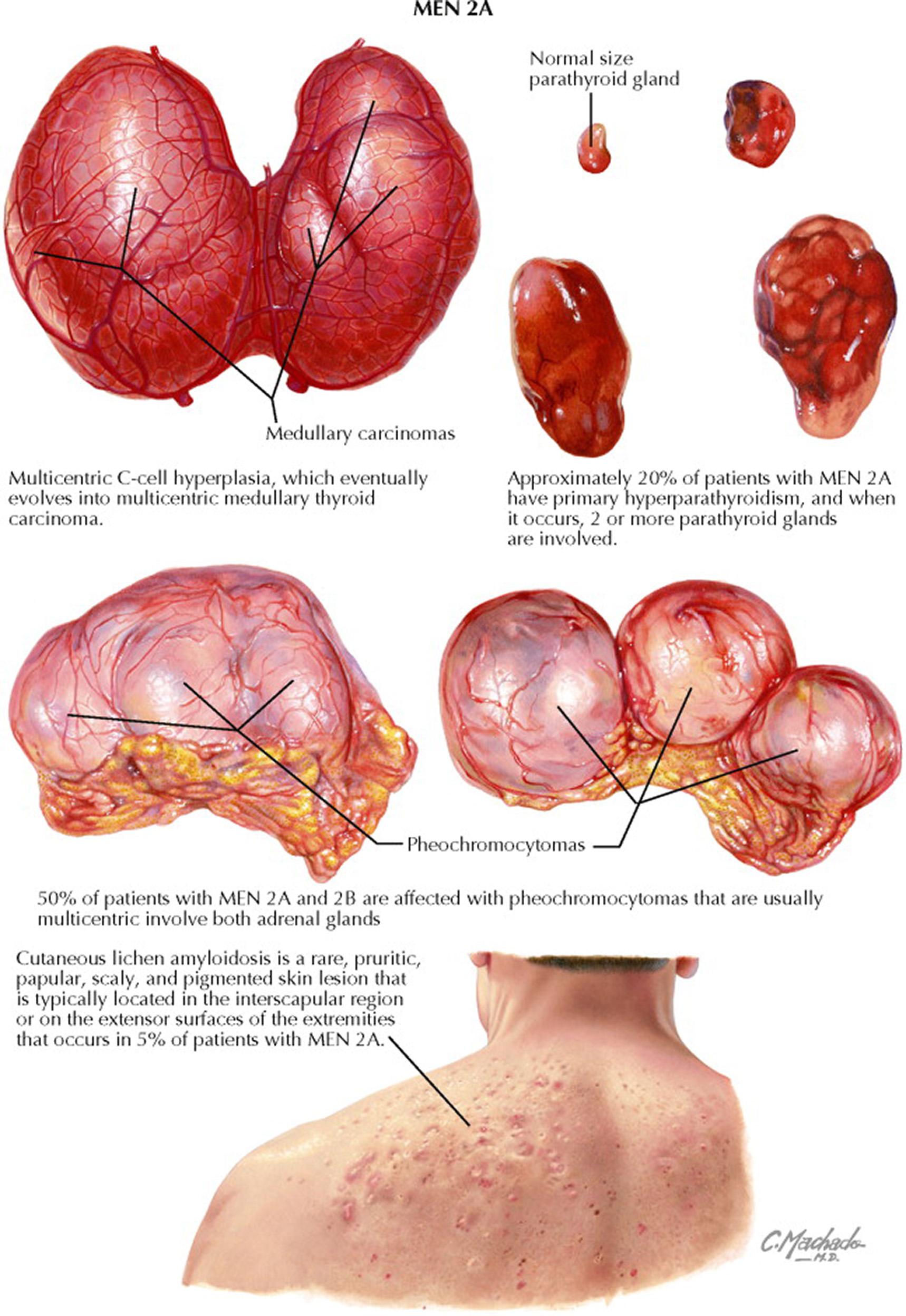Physical Address
304 North Cardinal St.
Dorchester Center, MA 02124
Multiple endocrine neoplasia type 1 (MEN 1) is a rare (prevalence ∼two per 100,000) autosomal dominant endocrine disorder that is characterized by neoplasms of the pituitary, parathyroid, and pancreas. In addition, neoplasms may arise in the adrenal glands, duodenum (gastrinoma), lung (carcinoid tumor), thymus gland (carcinoid tumor), and esophagus (leiomyoma). An MEN1 mutation is highly probable in a patient with two of the three main MEN 1 tumor types (pituitary, parathyroid, or gastroenteropancreatic [GEP] endocrine neoplasms).

Primary hyperparathyroidism is the most common manifestation of MEN 1; the penetrance is 100% by age 50 years. The diagnosis is biochemical with documentation of hypercalcemia and a nonsuppressed serum parathyroid hormone (PTH) concentration. All four (or occasionally five) of the parathyroid glands are involved, and removing 3.5 of the parathyroid glands is the treatment of choice. Recurrent hypercalcemia may require reoperation or percutaneous ethanol injection.
Pituitary adenomas are found in 20% of patients with MEN 1. Prolactinomas are the most common pituitary tumor. However, all pituitary tumor cell types have been identified in MEN 1 kindreds, including growth hormone (GH), corticotropin (adrenocorticotropic hormone [ACTH]), gonadotropin, and null cell. The management of pituitary tumors in patients with MEN 1 is the same as that for patients with sporadic pituitary neoplasms (see Plate 1-19, Plate 1-20, Plate 1-21, Plate 1-22, Plate 1-23, Plate 1-24 ).
The GEP neoplasms are the major life-threatening manifestation of MEN 1. Pancreatic islet cell (often nonfunctioning) and duodenal carcinoid tumors are frequently malignant and may metastasize. Peptic ulcer disease is the most common symptomatic presentation related to GEP tumors and is caused by gastrin-secreting neoplasms (Zollinger-Ellison syndrome). Zollinger-Ellison syndrome is the initial manifestation of MEN 1 in 40% of patients. The gastrinomas are frequently small, multifocal, and localized to the duodenum. The hypercalcemia from primary hyperparathyroidism may aggravate gastrin hypersecretion in Zollinger-Ellison syndrome. Thus, normalization of the serum calcium concentration is important in the management of patients with this syndrome. Proton pump inhibitors very effectively control the signs and symptoms related to hypergastrinemia. Removal of the gastrin-secreting duodenal carcinoids may be considered at the time of a pancreatic operation.
The pancreatic islet tumors may hypersecrete insulin, glucagon, human pancreatic polypeptide, chromogranin A, and vasoactive intestinal polypeptide. Insulinomas in MEN 1 may be small and numerous (see Plate 5-22 ). Cushing syndrome (see Plate 3-9 ) in individuals with MEN 1 may be caused by an ACTH-secreting pituitary tumor, a cortisol-secreting adrenal adenoma, or ectopic ACTH secretion from an islet cell tumor. Symptomatic islet cell tumors (e.g., insulinomas) should be resected. Pancreatic surgery should also be considered in patients with MEN 1 when a nonfunctioning pancreatic islet cell tumor is approaching 2 cm in diameter; larger islet cell tumors are more likely to be malignant and are prone to metastasize. The hormonal status of the GEP tumors can be monitored by annual measurement of gastrin, glucagon, human pancreatic polypeptide, and chromogranin A.
Patients with MEN 1 may have several skin manifestations. Angiofibromas, collagenomas, and subcutaneous lipomas occur in about 75% of patients with MEN 1. The dermal and subcutaneous lesions are benign and should be removed only if symptomatic. Patients with MEN 1 are also at risk of developing spinal cord ependymomas.
The MEN1 protein product is menin, and most MEN1 mutations inactivate or disrupt menin function. This tumor suppressor gene has no strong genotype–phenotype correlations. Most individuals with MEN 1 inherit 1 inactivated copy of MEN1 from an affected parent; tumorigenesis requires the subsequent somatic inactivation (e.g., gene deletion) of the remaining normal copy in a cell from a susceptible gland (e.g., parathyroid, pituitary, and pancreas). When an endocrine cell lacks menin tumor suppressor function, it begins the process of proliferation and neoplasia.
Multiple endocrine neoplasia type 2 (MEN 2) is an autosomal dominant disorder with an estimated prevalence of 2.5 per 100,000 in the general population, and it is classified into three distinct syndromes—MEN 2A, MEN 2B, and familial medullary thyroid cancer (FMTC). MEN 2A is characterized by medullary thyroid cancer (MTC) in all patients, pheochromocytoma in 50%, primary hyperparathyroidism in 20%, and cutaneous lichen amyloidosis in 5%. MEN 2B is characterized by MTC in all patients, pheochromocytoma in 50%, mucocutaneous neuromas (typically involving the tongue, lips, and eyelids) in most patients, skeletal deformities (kyphoscoliosis or lordosis), joint laxity, myelinated corneal nerves, and intestinal ganglioneuromas (Hirschsprung disease). FMTC is a variant of MEN 2A, and the clinical presentation is limited to MTC.

MTC is a neuroendocrine tumor of the parafollicular C cells of the thyroid gland and accounts for approximately 3% to 5% of all primary thyroid cancers. C cells—representing 0.1% of thyroid mass and concentrated in the upper third of the thyroid gland—are neuroendocrine cells derived from the ultimobranchial bodies. Multicentric C-cell hyperplasia is found in all patients with MEN 2, and nearly all eventually develop MTC. The C cells produce calcitonin, a 32–amino acid peptide that regulates blood calcium levels in fish. However, a physiologic role for this hormone in humans is unknown. MTC in MEN 2 is multicentric and is concentrated in the upper third of the thyroid gland, reflecting the normal distribution of C cells. Approximately 25% of all patients with MTC have a family history of this disease. whereas in MEN 2A and FMTC, the peak incidence of clinical detection of index cases is in the third decade of life, the typical age of presentation of sporadic MTC is in the fifth to sixth decades of life. When diagnosed as an index case, the clinical presentation (e.g., thyroid nodule) and manifestations (e.g., cervical adenopathy) of MEN 2–associated MTC are similar to those of sporadic MTC. Serum calcitonin concentrations have a positive correlation with tumor mass. MTC in patients with MEN 2B is earlier in onset and more aggressive (e.g., metastatic disease at a young age).
Become a Clinical Tree membership for Full access and enjoy Unlimited articles
If you are a member. Log in here